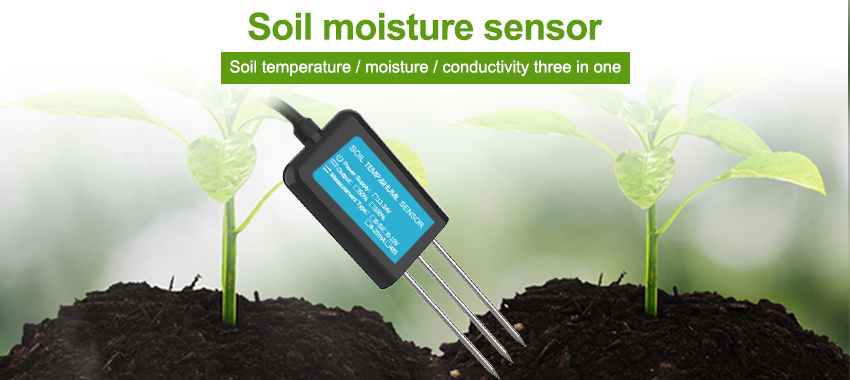Soil sensors are essential tools in precision agriculture, providing valuable data on soil conditions that help farmers optimize their farming practices. These sensors come in various types and categories, each designed to measure specific parameters related to soil health and fertility. This comprehensive article explores the main categories of soil sensors, their functionalities, advantages, and applications in modern agriculture.

I. Soil Moisture Sensors:
Soil moisture sensors are widely used in precision agriculture to measure the water content in the soil. They provide crucial information about soil moisture levels, helping farmers make informed decisions regarding irrigation management. The main categories of soil moisture sensors include:
Tensiometers:
Tensiometers measure soil moisture by monitoring the tension or suction pressure exerted by the soil water. They consist of a porous ceramic cup connected to a water-filled tube. As soil moisture decreases, water is drawn out of the cup, resulting in a decrease in pressure. Tensiometers are simple and affordable but require regular maintenance and calibration.
Capacitance Sensors:
Capacitance sensors measure soil moisture based on changes in the dielectric properties of the soil. These sensors use electrodes to measure the electrical capacitance of the soil, which is directly related to soil moisture content. Capacitance sensors are versatile, accurate, and can be installed at different depths in the soil.
Time Domain Reflectometry (TDR) Sensors:
TDR sensors measure soil moisture by sending an electromagnetic pulse through the soil and measuring the time it takes for the pulse to return. The time delay is proportional to soil moisture content. TDR sensors provide accurate and reliable measurements but can be expensive compared to other types of soil moisture sensors.
II. Soil Temperature Sensors:
Soil temperature sensors play a crucial role in monitoring soil temperatures, which directly influence plant growth and microbial activity. Different categories of soil temperature sensors include:
Thermistors:
Thermistors are the most commonly used soil temperature sensors. They are based on the principle of resistance change with temperature. Thermistors are affordable, accurate, and can be easily installed at different soil depths. However, they require calibration and are susceptible to damage from excessive moisture or physical impact.
Thermocouples:
Thermocouples consist of two dissimilar metal wires that generate a voltage proportional to the temperature difference between the two junctions. They are durable, have a wide temperature range, and are suitable for harsh environments. However, thermocouples are less accurate than other types of soil temperature sensors and require careful installation.
Resistance Temperature Detectors (RTDs):
RTDs use the principle of electrical resistance change with temperature. They provide highly accurate temperature measurements, have a wide temperature range, and are resistant to environmental factors. However, RTDs are relatively expensive compared to other sensors and require precise calibration.
III. Soil Nutrient Sensors:
Soil nutrient sensors measure the concentration of essential nutrients in the soil, allowing farmers to optimize fertilizer applications. The main categories of soil nutrient sensors include:
Ion-Selective Electrodes (ISE):
ISE sensors detect specific ions, such as nitrogen (N), phosphorus (P), potassium (K), and other micronutrients. These sensors consist of an electrode that selectively interacts with the desired ion and produces an electrical signal proportional to its concentration. ISE sensors are accurate and reliable but require regular calibration and maintenance.
Optical Sensors:
Optical sensors utilize light absorption or fluorescence properties to measure soil nutrient levels. These sensors emit light at specific wavelengths and measure the response of the soil based on nutrient concentration. Optical sensors are non-destructive, fast, and suitable for real-time monitoring. However, they may require complex calibration procedures and are sensitive to environmental factors.
IV. Soil pH Sensors:
Soil pH sensors measure the acidity or alkalinity of the soil, which is crucial for nutrient availability and plant growth. Different categories of soil pH sensors include:
Electrochemical Sensors:
Electrochemical sensors measure pH by detecting the electrical potential difference between two electrodes immersed in a soil solution. These sensors are affordable, portable, and provide instant pH measurements. However, they require regular calibration and maintenance.
Optical Sensors:
Optical pH sensors use indicators that change color based on pH levels. They measure the color changes using photodiodes or image analysis techniques. Optical pH sensors are easy to use, non-destructive, and provide rapid results. However, they may be affected by soil properties and require periodic recalibration.
V. Applications and Benefits of Soil Sensors:
Soil sensors find numerous applications in precision agriculture, including:
Irrigation Management:
Soil moisture sensors help optimize irrigation schedules, avoiding overwatering or underwatering and promoting water-use efficiency.
Fertilizer Optimization:
Soil nutrient sensors enable precise fertilizer application, matching nutrient supply to crop demand and reducing environmental impacts.
Crop Health Monitoring:
Soil sensors aid in monitoring soil conditions that affect plant health, allowing early detection and intervention for optimal crop growth.
Site-Specific Management:
Soil sensors contribute to site-specific management practices, such as variable rate application of water and nutrients, based on soil variability within fields.
The benefits of using soil sensors in agriculture include:
Improved Resource Efficiency: Soil sensors facilitate optimal resource usage, leading to reduced water, fertilizer, and energy wastage.
Enhanced Crop Productivity:
Accurate monitoring and management of soil conditions result in healthier crops, increased yields, and improved quality.

Environmental Sustainability: Precision agriculture driven by soil sensors minimizes environmental impact through targeted inputs, reducing chemical runoff and water pollution.
Cost Savings: Soil sensors help farmers make informed decisions, reducing input costs associated with excess irrigation, fertilization, and crop losses.
Conclusion: Soil sensors play a vital role in precision agriculture by providing real-time data on soil moisture, temperature, nutrients, and pH levels. The main categories of soil sensors include soil moisture sensors, soil temperature sensors, soil nutrient sensors, and soil pH sensors. Each category has its advantages and applications in optimizing farming practices. By leveraging the power of soil sensor technology, farmers can make informed decisions, maximize resource efficiency, improve crop productivity, and contribute to sustainable agricultural practices.